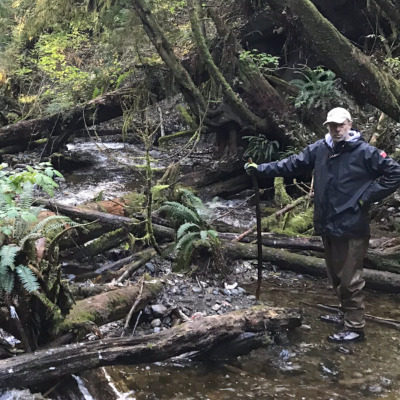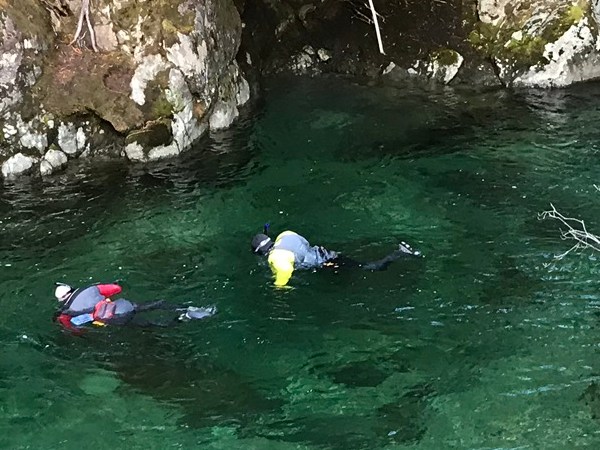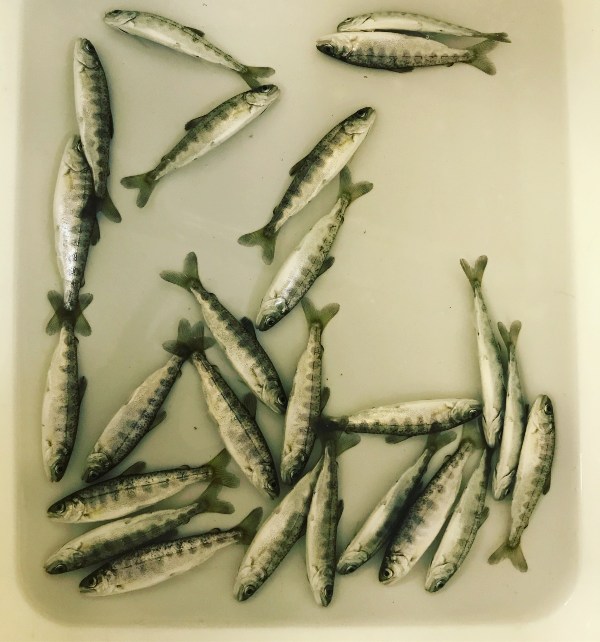Counting salmon in the river
How do Salmon get Counted?
By James Costello
One of the most basic, yet challenging, tasks for those involved with salmon enhancement efforts is to get an accurate count of the fish they are trying to help. In the fast moving (and often murky) waters of a river – it can be very hard to figure out just how many salmon there are at any given time. Depending on the stage of life you are trying to observe, counting salmon can be a tough job in the wild – here we will look at a few ways it can be done.
(In another article I will look at how a typical hatchery might be set up to count and collect fish, but today let’s go through what it takes to do it outside in the natural world.)
 One of the most straightforward ways to count salmon is when they return to spawn, and this can often be done by hatchery staff or volunteers walking up and down the riverbank and counting fish that are seen – this is called a stream survey. This was historically the only method available and counts from over 100 years ago are still part of records kept by many different organizations. These counts were rough data, meaning sometimes they counted in 100’s or even 1000’s of fish at a time when they surveyed the runs. What they weren’t able to do was see fish when the water was murky, or turbid, and some parts of the river simply can’t be walked because of big cliffs or other hazards – also, the counts that they get only show the fish that might be in the river on that day. While the same method is still often used, the limitations are still the same for this type of assessment. To improve on the chances of getting a good estimate, multiple surveys have to be done at different times of the salmon run. (When salmon return to spawn they don’t all come in at once - it can take weeks for all the fish to show up from the ocean!) By comparing the different counts, a calculation can then be made that shows what the total run size might be. Although some of the challenges remain, today’s technology allows us to get to places we couldn’t before with things like helicopters and rafts, and also means that we can spend more time counting and less time getting there.
One of the most straightforward ways to count salmon is when they return to spawn, and this can often be done by hatchery staff or volunteers walking up and down the riverbank and counting fish that are seen – this is called a stream survey. This was historically the only method available and counts from over 100 years ago are still part of records kept by many different organizations. These counts were rough data, meaning sometimes they counted in 100’s or even 1000’s of fish at a time when they surveyed the runs. What they weren’t able to do was see fish when the water was murky, or turbid, and some parts of the river simply can’t be walked because of big cliffs or other hazards – also, the counts that they get only show the fish that might be in the river on that day. While the same method is still often used, the limitations are still the same for this type of assessment. To improve on the chances of getting a good estimate, multiple surveys have to be done at different times of the salmon run. (When salmon return to spawn they don’t all come in at once - it can take weeks for all the fish to show up from the ocean!) By comparing the different counts, a calculation can then be made that shows what the total run size might be. Although some of the challenges remain, today’s technology allows us to get to places we couldn’t before with things like helicopters and rafts, and also means that we can spend more time counting and less time getting there.  If walking on shore isn’t the greatest way to do it, then a better way is to get right in the water with the fish! This can be done with a snorkel survey and is one of my favorite parts of working in salmon enhancement. By getting wet we can get a much better view of what is happening in the river, and using this method are able to get a more accurate count of fish as they swim by us. While we still have to consider many of the same things as when walking the shore, we can often get a much better idea of how many fish are in the river at any given time. We have to be careful though, because the river can sometimes be turbid and moving very fast – you have to have your head on a swivel and make sure you are safe while trying to count at the same time! There are often days where it simply isn’t safe to get in the water and you have to rely on estimates to fill in the gaps where swimmers weren’t able to provide first-hand information, or data.
If walking on shore isn’t the greatest way to do it, then a better way is to get right in the water with the fish! This can be done with a snorkel survey and is one of my favorite parts of working in salmon enhancement. By getting wet we can get a much better view of what is happening in the river, and using this method are able to get a more accurate count of fish as they swim by us. While we still have to consider many of the same things as when walking the shore, we can often get a much better idea of how many fish are in the river at any given time. We have to be careful though, because the river can sometimes be turbid and moving very fast – you have to have your head on a swivel and make sure you are safe while trying to count at the same time! There are often days where it simply isn’t safe to get in the water and you have to rely on estimates to fill in the gaps where swimmers weren’t able to provide first-hand information, or data. One of the big advantages of swimming the river is that we can clearly see the condition of the fish – meaning, we can observe whether a salmon has just entered the river from the sea and is still silver, whether it is a female and has been using its tail to build a redd, whether it is a wild or hatchery fish (missing its adipose fin), or whether it has already spawned. Using different calculations based on the observations seen by those in the field, biologists can make educated guesses to fill in the blanks. By collecting all of this data, salmon enhancement workers, or biologists, can then paint a picture of what is happening in nature. By comparing these pictures, they are able to see which salmon runs are doing well, and which might need more help.
 So far, we’ve looked at how biologists and volunteers can count adult salmon returning to spawn - but while we are still in freshwater it’s important to have a look at how the next generation of fish can be assessed. Because these can be tiny (a salmon can hatch out of the egg at less than 0.3g) and because they spend a big part of their early life under the gravel where they are safe from predators, they can be really hard to see using methods previously discussed. This is where a combination of math and some pretty neat technology can come in. By using the totals of adult fish collected biologists are able to estimate how many eggs they would have laid. If you are able to get a ratio of male to female fish, you can figure out how many pairs there would be – from there you can estimate how many eggs will be laid by using the fecundity, or how many eggs each female salmon has inside her.
So far, we’ve looked at how biologists and volunteers can count adult salmon returning to spawn - but while we are still in freshwater it’s important to have a look at how the next generation of fish can be assessed. Because these can be tiny (a salmon can hatch out of the egg at less than 0.3g) and because they spend a big part of their early life under the gravel where they are safe from predators, they can be really hard to see using methods previously discussed. This is where a combination of math and some pretty neat technology can come in. By using the totals of adult fish collected biologists are able to estimate how many eggs they would have laid. If you are able to get a ratio of male to female fish, you can figure out how many pairs there would be – from there you can estimate how many eggs will be laid by using the fecundity, or how many eggs each female salmon has inside her. Female salmon can have 2000 to 5000 eggs depending on the species and size of fish. With this number you can then start subtracting factors like fertilization rate (how many eggs actually start to grow), and survival rate (how many eggs hatch and grow into juvenile salmon). Typically, if there are 3000 eggs laid you will have only 300 alevins hatch out, and then only 50 smolt heading out to sea. Once the salmon are in the ocean there may only be 4 adults left, and 2 of those might return to spawn in the river – hence the large number of eggs to begin with!
Once the math is done – like always – you will want to check your work, right? This is where salmon biologists can use technology to help them get better data for their science efforts. By placing traps in the river, they can collect juvenile salmon as they migrate out to the ocean. They carefully measure the fish and then release them back onto the river to carry on in their journey. Using this data, they can compare what they see to what they may have expected from estimates, as well as checking on how big the fish are when they are caught.
As you can see it’s not easy to get good data when it comes to salmon populations in their freshwater environment, and we didn’t even look at the ocean!
Next time we will look at how adult salmon are collected by salmon enhancement staff and volunteers to be used in the hatchery – stay tuned.
Salmon enhancement is a one of his strong passions and he is hoping you get more of an understanding into what happens away from public view to keep salmon numbers strong.



